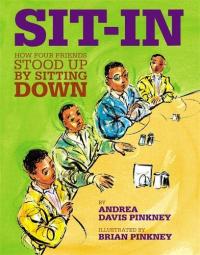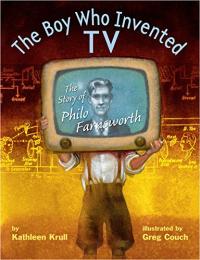
High in the Appalachian hills, a woman comes every two weeks on horseback to deliver books to Cal’s family. Cal has no interest in reading, but he wonders what could possibly make her long treks in the snow and wind worthwhile? Young readers will discover a moving introduction to the story and courage of Kentucky’s Pack Horse Librarians.
That Book Woman

Though the first U.S. Census didn’t start until 1790, the Forest Lake Elementary School elementary children put on a play that lays the historical foundation for it. The kids (sporting shapes of the original 13 states) dramatize the problems faced after the American Revolution which were resolved by the 1787 Constitutional Convention. This entertaining look at the county’s start is sure to engage and inspire further research.
Unite or Die! The Story of the Thirteen Colonies

Rachek always begs her Grandmother Oma to tell the story of Oma’s two lives: the one before American and the one after. The first part recounts her marriage prior to World War I and then her family’s move from Poland to Germany to seek safety. Ironically, two of her three daughters spent time in concentration camps but all survived and were reunited in the United States. The illustrations really add to readers’ understanding of this horrible time in history.
Always Remember Me: How One Family Survived World War II

“My name is Gabriela Mistral. It is a name I chose myself because I like the sound of it.” With these words, Monica Brown introduces us to the Chilean poet and author who, in 1945, became the first Latin American writer to win the Nobel Prize in Literature. The lyrical text and exquisite illustrations bring Gabriela’s childhood and talent to life for young readers.
My Name Is Gabriela: The Life of Gabriela Mistral / Me llamo Gabriela: la vida de Gabriela Mistral

The author/illustrator of much-loved picture books is introduced here from her Minnesota childhood to the publication of her Newbery Honor book, Millions of Cats (1928). Each double page spread includes a quote from Gag’s diary followed by a straightforward text coupled with an evocative illustration. An author’s note includes more information, a photograph of Gag, and sources used.
Wanda Gag, the Girl Who Lived to Draw

When Emily Post’s book of etiquette enters the young narrator’s house, his mother uses it to limit her children’s behavior; that is, until the children remind their mother of her Post transgressions. Characters from Emily Post’s book (such as Mrs. Worldly) reveal that even Emily misbehaved sometimes in this playful introduction to etiquette, family, and the early 20th century.
Thanks a LOT, Emily Post!

Brief, lighthearted looks at the wives of the U.S. Presidents from Martha Washington to Michelle Obama are presented as if put together as a class activity. In a note to their teacher, Team USA concludes, “A lot has changed since 1789, but some things are still the same — the president is still a man, and you still don’t get paid to be first lady!”
Smart About the First Ladies

The true story of one of only two Chinese-American women to fly for the U.S. Air Force during World War II, is told as though by Maggie Gee herself. Her dream of flying became reality because of a dream and determination. An author’s note provides a short glimpse into where and what the actual Maggie Gee does today as well as period photographs.
Sky High: The True Story of Maggie Gee

When John and Abigail first met, they didn’t really like each other but came to appreciate the other’s strengths: Abigail had her own opinions; John was honest and witty. After their marriage, Abigail expertly handled home, family, and more during her husband’s frequent travel and was the earliest First Lady to live in the Executive Mansion. This is a graceful introduction to an early first family. View this exclusive digital version of Abigail and John
A Picture Book of John and Abigail Adams

Cassius Clay learned to box when he was twelve, trained by Joe Martin in his native Louisville, Kentucky. He would go on to win the Golden Gloves championship and to box in the Olympics. Clay stunned not only the sports world but the world as a whole by winning the world boxing championship and changing his name to Muhammad Ali when he embraced Islam. His portrait is painted in a chronological account, highlighting Ali’s words in text and dramatic full-color paintings.
Muhammad Ali: The People’s Champion

Martin Luther King, Jr. prepared diligently for his now famous “I have a dream” speech given on August 28, 1963 during the March on Washington for Jobs and Freedom. It was King’s unshakable belief in nonviolence and the power of words that galvanized the country. This informal account is both personal and satisfying as revealed by Martin’s older sister who watched it on television with their parents in Atlanta. Full-color illustrations and expressive typography highlight words and enhance the tone.
March On! The Day My Brother Martin Changed the World

In spite of growing up in the 1940s before the United States was integrated, in a segregated Mobile, Alabama, Henry Aaron dreamed of playing baseball. His perseverance and courage paid off; he was to become one of the most talented and revered players, whose major league career spanned from 1954 through 1976. He was also a vocal spokesperson for equality between white and black players. Aaron’s early life, his career, and his impact on the game are revealed in an honest, sometimes difficult text and richly colored paintings.
Henry Aaron’s Dream

The youngest daughter of civil rights leader Andrew Young shares a time when she and her two older sisters moved from New York to Atlanta to protest and ultimately change unfair laws. The narration is innocent and child-like — effectively describing what Jim Crow was and giving glimpse of the leaders of the period (including Martin Luther King, Jr.). Soft lined, textured illustrations evoke the time and its tenor while portraying people in a recognizable way. An end note provides additional information about the people depicted.
Child of the Civil Rights Movement

The words of Dr. Martin Luther King, Jr., inspired four students to protest in a way that ultimately changed the United States. Their peaceful dissent at the segregated lunch counter in Greensboro, North Carolina, would “combine black with white to make sweet justice.” The “Greensboro Four” began their sit-in on February 1, 1960 and contributed to the passage of the 1964 Civil Rights Act. The text suggests storytelling and is accompanied by light-lined but evocative illustrations; back matter completes this compelling portrait.
Sit-In: How Four Friends Stood Up by Sitting Down

Aldrin relates how he, the second man to walk on the Moon, became interested in aeronautics and flying. The result is a fascinating look at his personal history as well as the history of flight accompanied by precise but equally engaging illustrations.
Reaching for the Moon

Two machines captivated young Philo Farnsworth: a telephone and a phonograph. Both had cranks and both connected people with others (one in real time, the other through music). These and other inspirations motivated young Philo to invent what was to become known as the television. His early story is fascinatingly told and well illustrated.
The Boy Who Invented TV: The Story of Philo Farnsworth

When Nettie and her family travel to the South, they see enslaved people. Nettie is literally sickened by it and realizes how wrong slavery is. This fictional story is both realistic and heart wrenching. Readers sense that Nettie will grow into an Abolitionist much like Louisa May Alcott became.
Nettie’s Trip South

Massachusetts may be best known as the place where Pilgrims landed on Plymouth Rock. This New England state was also home to the Alcott who made their permanent home in the Orchard House (opens in a new window) family in Concord, Massachusetts.
Massachusetts

A dapper brown bear named Henry and his friend decide to visit another town. As Henry hikes, he leisurely soaks in the flora and fauna as he meets a number of his contemporaries (and a sly way to introduce historical figures such as Mrs. Alcott, Mr. Emerson, and Mr. Hawthorne). His friend, however, misses these as he takes the train. Other books about Henry are also inspired by Thoreau and provide a brief introduction to his life and beliefs.
Henry Hikes to Fitchburg

Louisa May Alcott briefly worked as a nurse during the Civil War before becoming ill herself. In this Magic Tree House fantasy, Jack and Annie travel back to the Civil War, meeting Clara Barton and help nurse the soldiers wounded in battle.
Civil War on Sunday

Even though there’s a special day called Children’s Day/Book Day, children and books can be celebrated everyday and in any place as is demonstrated in this vibrant book. Energetic illustrations show a wide range of children and animals playing, reading, and just plain having fun with each other and with books.
Book Fiesta!

Imogene’s town has abandoned the building which she makes into a museum. Can feisty Imogene save the museum from destruction in the name of progress? She finds a letter (George Washington slept there!), protests, and puts herself in a stockade until the building is saved. This book is fast, funny, and rich with an appreciation for history.
Imogene’s Last Stand

Baseball great, Jackie Robinson, never joined his children at the lake near their Connecticut home until the winter he made sure its ice was safe for skating. His daughter recognizes that courage is shown in many ways — from testing ice to breaking the baseball color barrier. Rich illustrations extend this well-told family story.
Testing the Ice

Ten year old Allie Sherman resists her family’s move until she learns that they will live on Strawberry Hill. It is on this intriguing sounding street that Allie finds a friend, confronts racism, and comes to appreciate her family. Set during the Great Depression, this nostalgic novel continues to ring true.
